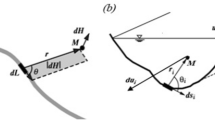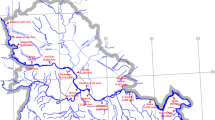Abstract
This study proposes a new formulation technique for modeling stage–discharge relationship, as an alternative approach to standard regression techniques. An explicit neural network formulation (ENNF) is derived by using data obtained from United States Geological Survey data base. The neural network model is trained and tested using time series of daily stage and discharge data from two stations in Pennsylvania, USA. The model is compared with the standard rating curve (SRC) technique. Statistical parameters such as average, standard deviation, minimum, and maximum values, as well as criteria such as root mean square error, the efficiency coefficient (E), and determination coefficient (R 2) are used to measure the performance of the ENNF. Considerably, well performance is achieved in modeling streamflow by using ENNF. The comparison results reveal that the suggested formulations perform better than the conventional SRC.






Similar content being viewed by others
References
Ab. Ghani A, Chang CK, Leow CS, Zakaria NA (2012) Sungai Pahang digital flood mapping: 2007 flood. Int J River Basin Manag 10(2):139–148
Akaike H (1974) A new look at the statistical model identification. IEEE Trans Autom Control AC-19:716–723
Alavi AH, Gandomi AH, Mollahasani A, Heshmati AAR, Rashed A (2010) Modeling of maximum dry density and optimum moisture content of stabilized soil using artificial neural networks. J Plant Nutr Soil Sci 173(3):368–379
Alavi AH, Gandomi AH (2011) Prediction of principal ground-motion parameters using a hybrid method coupling artificial neural networks and simulated annealing. Comput Struct 89(23–24):2176–2194
ASCE Task Committee (2000) Artificial neural networks in hydrology. I: preliminary concepts. J Hydrol Eng 5(2):115–123
ASCE Task Committee (2000) Artificial neural networks in hydrology. II: hydrologic applications. J Hydrol Eng 5(2):124–137
Azamathulla HM, Ghani A, Leow CS, Chang CK, Zakaria NA (2011) Gene-expression programming for the development of a stage-discharge curve of the Pahang River. Water Resour Manag 25(11):2901–2916
Bhattacharya B, Solomatine DP (2000) Application of artificial neural network in stage-discharge relationship. In: Proceedings of 4th international conference on hydroinformatics. IAHR, Iowa City
Fread DL (1973) A dynamic model of stage-discharge relations affected by changing discharge. NOAA Tech. Memo. NWS HYDRO-16, National Weather Service, Silver Spring
Fread DL (1975) Computation of stage-discharge relationships affected by unsteady flow. Water Resour Bull 11(2):213–228
Gandomi AH, Alavi AH, Mirzahosseini MR, Moqhadas Nejad F (2011) Nonlinear genetic-based models for prediction of flow number of asphalt mixtures. J Mater Civ Eng ASCE 23(3):248–263
Gandomi AH, Tabatabaie SM, Moradian MH, Radfar A, Alavi AH (2011) A new prediction model for load capacity of castellated steel beams. J Constr Steel Res 67(7):1096–1105
Gandomi AH, Babanajad SK, Alavi AH, Farnam Y (2012) A novel approach to strength modeling of concrete under triaxial compression. J Mater Civ Eng ASCE (in press). doi:10.1061/(ASCE)MT.1943-5533.0000494
Gandomi AH, Alavi AH (2011) Applications of computational ıntelligence in behavior simulation of concrete materials. In: Yang XS, Koziel S (eds) Chapter 9 in computational optimization and applications in engineering and industry, vol 359. Springer SCI, pp 221–243
Gandomi AH, Alavi AH (2011) Multi-stage genetic programming: a new strategy to nonlinear system modeling. Inf Sci 181(23):5227–5239
Gandomi AH, Alavi AH (2012) A new multi-gene genetic programming approach to nonlinear system modeling. Part II: geotechnical and earthquake engineering problems. Neural Comput Appl 21(1):189–201
Goh ATC, Kulhawy FH, Chua CG (2005) Bayesian neural network analysis of undrained side resistance of drilled shafts. J Geotech Geoenviron Eng 131(1):84–93
Guven A, Gunal M, Cevik AK (2006) Prediction of pressure fluctuations on stilling basins. Can J Civ Eng 33(11):1379–1388
Guven A, Aytek A, Yuce MI, Aksoy H (2007) Genetic programming-based empirical model for daily reference evapotranspiration estimation. Clean-Soil Air Water 36(10–11):905–912
Guven A, Aytek A (2009) A new approach for stage-discharge relationship: gene-expression programming. J Hydrol Eng 14(8):812–820
Haykin S (1999) Neural networks: a comprehensive foundation. Pearson Education Inc., New Jersey
Jain SK, Chalisgaonkar D (2000) Setting up stage-discharge relations using ANN. J Hydrol Eng 5(4):428–433
Legates DR, McCabe GJ (1999) Evaluating the use of goodness-of-fit measures in hydrologic and hydroclimatic model validation. Water Resour Res 35(1):233–241
Liao H, Knight DW (2007) Analytic stage–discharge formulae for flow in straight trapezoidal open channels. Adv Water Resour. doi:10.1016/j.advwatres.2007.05.002
Liong SY, Lim W, Paudyal GN (2000) River stage forecasting in Bangladesh: neural network approach. J Comput Civ Eng 14(1):1–18
Lohani AK, Goel NK, Bhatia KKS (2007) Deriving stage–discharge–sediment concentration relationships using fuzzy logic. Hydrol Sci 52(4):793–807
Maier HR, Dandy GC (2000) Neural networks for the prediction and forecasting of water resources variables: a review of modeling issues and applications. Environ Model Softw 15(1):101–124
Overleir P (2006) Modelling stage–discharge relationships affected by hysteresis using the Jones formula and nonlinear regression. Hydrol Sci 51(3):365–388
Overleir P (2006) A robust stage-discharge rating curve model based on critical flow from a reservoir. Hydrol Res 37(3):217–233
Panagoulia D (2006) Artificial neural networks and high and low flows in various climate regimes. Hydrol Sci 51(4):563–587
Schmidt AR, Yen BC (2002) Stage-discharge ratings revisited. In: Wahl TL, Pugh CA, Oberg KA, Vermeyen TB (eds) Hydraulic measurements and experimental methods, Proceedings of EWRI and IAHR joint conference, Estes Park
Sivapragasam C, Mutill N (2005) Discharge rating curve extension—a new approach. Water Resour Manag 19:505–520
Sudheer KP, Jain SK (2003) Radial basis function neural network for modeling rating curves. J Hydrol Eng 8(3):161–164
Supharatid S (2003) Application of a neural network model in establishing a stage-discharge relationship for a tidal river. Hydrol Process 17(15):3085–3099
Tawfik M, Ibrahim A, Fahmy H (1997) Hysteresis sensitive neural network for modeling rating curves. J Comput Civ Eng 11(3):206–211
Thirumalaiah K, Deo MC (1998) River stage forecasting using artificial neural networks. J Hydrol Eng 3(1):26–32
Torsten D, Gerd M, Torsten S (2002) Extrapolating stage-discharge relationships by numerical modeling. In: International conference on hydraulic engineering, Warshaw, pp 1–8
Acknowledgments
The data used in this study were downloaded from the web server of the USGS. The authors wish to thank the staff of the USGS who are associated with data observation, processing, and management of USGS Web sites.
Author information
Authors and Affiliations
Corresponding author
Rights and permissions
About this article
Cite this article
Guven, A., Aytek, A. & Azamathulla, H.M. A practical approach to formulate stage–discharge relationship in natural rivers. Neural Comput & Applic 23, 873–880 (2013). https://doi.org/10.1007/s00521-012-1011-5
Received:
Accepted:
Published:
Issue Date:
DOI: https://doi.org/10.1007/s00521-012-1011-5




